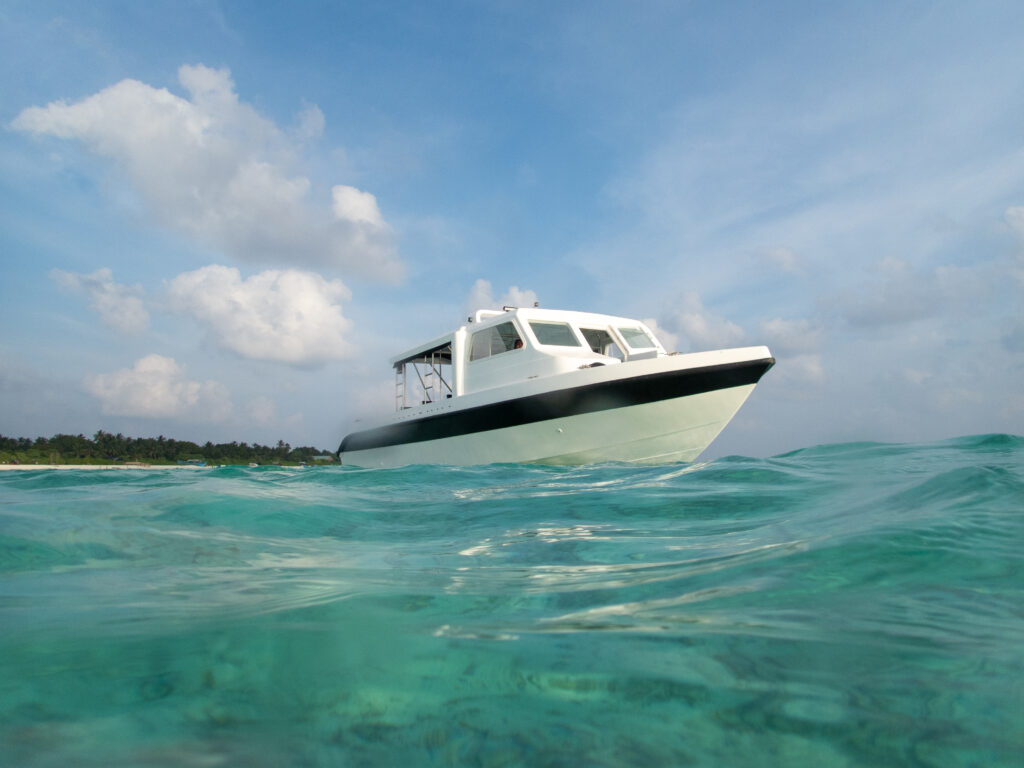DIVING IN MALDIVES

THODDOO, RASDHOO, UKULHAS DIVING: BEST DIVE SITES
Maldives is the world diving destination #1. Maldives has everything to prove it: clear warm water all year around, perfect visibility (20-40 m), and fantastic marine life. Corals, sponges, nudibranchs, fish, stingrays, dolphins, mantas, sharks – you name it.
Our dive center is situated on Thoddoo island (Alif Alif or North Ari atoll). This is one the most famous diving destinations in the Maldives. The beauty of this island is combined with a number of great dive sites reachable in 5-60 min of boat ride. Our boats, 36 feet 900 HP diving speedboat and 40 feet dhoni, are at your service!
Diving in Maldives features currents. Sometimes mild, sometimes strong, but always enjoyable. Jump in, adjust your buoyancy, and… just relax. Move with the waters along the reef walls (faru in Dhivehi), enjoy spectacular views of sea inhabitants, breath in, breath out. Napoleon wrasse, parrot fish, trigger fish, angel fish, snappers, groupers, sweetlips will be your companions in the journey. Mantas and reef sharks patrolling their areas or arriving to cleaning stations are often seen too.
Diving in channels (kandu in Dhivehi) between atolls and islands in Maldives sometimes can be challenging due to strong currents and visibility but always awesome because of greater chance to encounter sharks and mantas and better coral life.
There are some underwater rocks growing almost up to the surface called ‘thilas’. These formations are like stop signs for the currents, providing food for corals and sponges – favorite food of bigger fish, turtles and sharks. Best thila diving is near Ukulhas island (Maaya Thila, Hafsa thila, Maa thila).
Come and see for yourself!
Main point of interest of this dive site is a huge mushroom-shaped coral serving as a cleaning station for giant manta rays. The best season for manta diving is between November and March when Thoddoo hosts dozens of mantas. However, you can encounter them throughout the year, as few species prefer to stay in Thoddoo here all year around.
Two Towers is not just about mantas. For a change, with the right current, you can take a breathtaking drift dive between two main sightseeings – above mentioned ‘mushroom’ and a huge coral block, almost broken in half (“Broken head”). What to expect on the way: hawkbill and green sea turtles, silvertip sharks, white tip sharks, big tuna, eagle rays. One of the spots on the way to Broken head is called ‘A house of flying daggers’ – thats because of
Beware of triggerfish nesting around, remember to keep distance from the nests!
Another good idea is a deep drift on the outer ridge. Yeah, you guessed it right. Sharks! With the right sea conditions, you can encounter up to a dozen of full size silvertips and whitetips. Bottom dwelling stingrays are there, too.
When the current is down to minimum, it is a nice and easy excursion along the coral garden. Nudibranchs, ‘pots’ of anemones populated by funny clown fish, moray eels, all kinds of angelfish, butterfly fish… you will run out of memory on your card very soon 🙂
Read more…A great multi-dive site of Thoddoo, good for both professionals and beginners! Accessible practically all year around, so you won’t miss a thing 🙂
A typical scenario is a deep drift. Divers would go with the current passing by a coral ridge that goes down from 5m to 40m where it ends with a small cavern and then hover over the sandy plateau.
The plateau is the best spot to encounter schools of mobula rays and eagle rays. You can also see stingrays resting on the sea bed. Near the drop off you can encounter grey and white tips sharks. Mantas are also frequent visitors of this spot.
The ridge itself is an interesting spot, too. It is always like a busy aquarium. Very often you can see tuna and jackfish hunting small fish. A true action movie! 🙂
If you are not up for a deep dive, it is just as good as to stay shallow (10-15m). What’s cool to expect: green and hawksbill turtles, anemones, large schools of tropical fish and small white tip sharks.
Read more…The western reef of Thoddoo offers the best diving with turtles in the atoll. Typically, it is an easy and shallow (recommended depth – 15m) drift dive along this very long coral wall (>1 km!). There is a great variety of hard and soft corals, corals look healthy and vivid, and it looks like turtles do enjoy feeding and resting here. Fellow photographers will find a lot of interesting stuff in the coral gardens.
Western part of the island is also the spot where turtles come out to the beach to lay eggs. As per our observations, the population of turtles is growing, which makes our guests even happier 🙂
Rocky island, where we normally start the dive, is also an entrance to the sheltered lagoon. The channel is shallow (~3m), which makes it perfect for Open Water or Scuba Review training sessions.
This dive site is located just between the harbor and the South corner, offering at least two different scenarios on how to dive there.
Steep wall starts from 2 meters and goes down to about 20 meters deep. Coral life is quite good, the wall is populated by myriads of fish. Super easy dive – just drift with the current and enjoy the views. If the current is strong enough, you will end your dive near the ridge of the South corner where you will spend your safety stop playing with countless fish.
Deep divers will enjoy an alternative route. Just keep descending to 25m to the sandy carnice followed by another drop off. On the cornice, there are few coral pinnacles, but on the edge of the drop off you will find small caverns. You can see reef sharks cruising close to the wall and stingrays resting on the sandy patches.
In the north-weest part of the island, there is an extensive shallow coral plateau surrounded by gradual drop off. It is one of our favourite spots to dive during winter and spring.
The plateau itself is quite an interesting place for photographers. There are a lot of coral formations, blocks and pinnacles – each of them is hiding something cool. Very often you can see baby sharks and stingrays resting under the rocks. Octopuses and moray eels also like to hide inside and under corals.
However, a typical scenario would be a wall/drift dive on just over the edge from about 10m. Recommended depth would be around 15m. There are some nice spots not to miss – Lobster house (a small coral formation where you can sometimes see a dozen lobsters hiding under) and Shark nursery (small cavern where you can encounter a few small whitetips). On the way, you can also see turtles and sharks cruising around.
Thanks to changing currents, you can make 3-4 dives here and you will never get bored!
Madivaru corner is one of the most famous dive sites of North Ari atoll. It’s a must dive for every single liveaboard taking the Central route. During the high season, we go there almost every other day on our Rasdhoo diving trips. Why? Because we can! The ride is only 20 min by our speedboat and sharks are always there.
Madivaru corner is the place to dive with white tips and grey reef sharks. With the right sea conditions, you can see a couple dozen of them at once! More than this, very often we encounter schools of eagle rays, trevally and jackfishes, some huge Napoleon wrasse, and stingrays resting on sandy seabed.
While depth is OK for Open Water certification, strong currents can be an issue. So we strongly recommend prior visiting Madivaru corner to take some warm-up dives. Also, it is very important to follow the group formation and respect the depth as our non decompression time isn’t limitless. The use of reef hooks is recommended to avoid coral damage, as well as skin cuts and bites.
For the 2nd half of the dive, one of choices is to enter the channel and keep drifting inside, looking left and right for small sharks, schools of Batfish and barracudas. The depth is gradually decreasing to appx 10 meters. Time to shoot our SMBs and do our safety stops!
Another greatest hit of Rasdhoo dive trips is Rasdhoo channel which separates Kuramathi resort and the inhabited island of Rasdhoo. This dive is a bit more challenging due to greater depth (average 20-25 m), sometimes poor visibility and strong currents, but potentially more rewarding. Sharks! Sharks! More sharks!
The dive plan is quite easy: follow the edge of the drop off along the seabed and enjoy the show. On the way, there will be few large pinnacles where you can encounter resting turtles, large tunas and barracudas looking for their prey and of course sharks. Keep your eyes open for your special prize – manta rays! 🙂
If the current is strong enough, we might be able to cross the channel from island to island. But if not, and/or we are low on air/NDL, it is fine to let the current pull you inside the channel and do your safety stop on a shallower but still interesting part.
Kuramathi Queen is a supply boat sunk near the Kuramathi resort in 1987. Located in a sheltered location, resting at 20m depth, this wreck is great for fun diving, especially at night, as well as for wreck diving training.
Queen offers good penetration opportunities – you can explore her engine room, wheelhouse, and cargo holds. Night time the wreck looks gorgeous, providing shelter for many fish species. Make sure you have this spot booked for your Rasdhoo diving trip.
The Halaveli wreck (Highly 18) is another modern wreck. Despite the lack of history, this is still a nice object to visit. She was sunk in 1991 and now it is a true artificial reef, fully covered by corals and sponges.
This wreck is very good for wreck diving training. The deck is about 20 meter deep, while maximum depth is about 30 m.
Thila means ‘underwater hill’ or, as we, divers, know it, is a pinnacle (reef) coming from the seabed up to the surface. There are many thilas around, and Maaya thila is one of the most famous one. Maaya thila is offered on most Ukulhas diving trips when the weather permits.
Round shaped pinnacle is about 80 meters in diameter, so if you are a good breather you can circumnavigate it twice. The top of the thila is about 10 meters deep. The reef edge drops down to 30+ meters. Around the pinnacle, there are some rock formations. The big rock on the southern part has a nice swim-through. There are also overhangs, caverns and caves on the thila itself that are worth visiting and checking what’s inside.
Maaya thila is the place to dive with sharks. Very often we encounter a big school of barracudas. You can also watch how dog-toothed tunas hunt small fish. On the top of the reef you will find many anemones and colorful cups of soft corals. Moray eels, octopus and scorpion fishes can frequently be seen there.
Another classic thila for your next Ukulhas diving trip. A bit smaller than Maaya thila, but still very interesting dive site. Oval shaped reef starts about 10m deep and falls down to 35m meters. The best strategy is to fast descent to the reef and stay close to it, then swim along the wall. The walls have many overhangs and host black coral formations.
Marine life is superb! Almost always there are grey reef sharks, batfish, dogtooth, tunas and schools of fusiliers. The best spot to observe sharks is to hang on the corner exposed to the current. Use of reef hooks is recommended.
Boduga (in Dhivehi means “Big block”) is a great combination of wall, drift, deep and cavern diving (subject to your certification) with a greater variety of fish.
Deep divers would be tempted to explore a couple large overhangs on -30m. Once your non decompression time runs low, ascend to the small but very nice plateau decorated by some corals. We call it ‘fish house’ – there are always so many fish, so your camera will run out of memory very quickly. Also, look for white tips, slowly cruising around or resting on the sandbed of the plateau. The last part of the dive will be a shallow drift along the wall. Here you can find some lobster families. Macro lovers won’t be disappointed too.
The stronger the current, the more fun it is to drift this place. Sharks and eagle rays are often seen here. On the luckiest days you will encounter manta rays.
An absolute hit of our Ukulhas diving trips during the manta season (December to April).
On top of cleaning stations, mantas need to keep a near-stationary position so that cleaner fish can remove parasite and dead skin from them without causing any harm. Sometimes, unfortunately, it is not so easy, especially with strong currents, and in that situation you can see some mantas dart off due to a deep bite in very sensitive places like gills or open wounds!

